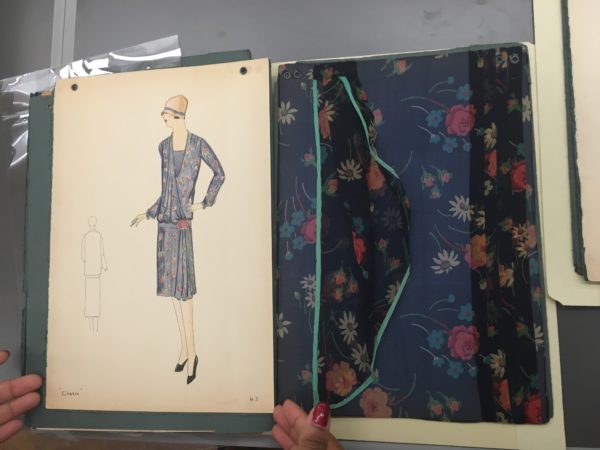The MA Documenting Fashion crew took New York City by storm last week! Stay tuned for posts about what we saw and did on our fabulous study-trip-extravaganza.
Our first visit was with April Calahan at FIT’s Special Collections department. April kindly showed us several boxes full of fashion illustrations, photographs and designs from the Twentieth Century, including the second issue of US Vogue and early designs from Chanel, Bonnie Cashin and Rudi Gernreich.
Among the treasures presented to us there was a folder containing late 1920s or 30s coloured sketches for designs made by Madame Margé, which was donated to the museum in 1957. There has been very little research done about Margé. She was born as Marguerite Norlin in 1978 in Philadelphia, and later Francophiled her name as was often the case for designers in the earlier Twentieth Century. Paris was then seen as the fashion central, but throughout the decades Margé was working it gradually shifted to include America. In New York and Chicago she owned fashion firms, selling the latest designs throughout the interwar period.[1]

The folder at FIT contained colour-washed fashion illustrations, alongside large swatches of fabric which covered the entire page next to each design. Underneath the designs were the name and number for each piece. It is unclear whether it was Margé herself who drew these, however they are highly effective for us appreciating the clothes because of their use of colour. Rich pastel tones are used to convey the notion of what it would be like to wear such beautiful items. The drawings also show how the clothes would have looked like from behind.


The most interesting aspect of these pages was the presence of generous fabric swatches beside the drawings instead of the tiny squares of fabric customarily included with sketches. These were added so that the customer could get a real feel for the design before buying it. The size of the swatches demonstrates how important fabric was for Margé. For example, ‘Cherie,’ design number 63, includes a highly tactile piece of sheer silk chiffon floral fabric, slightly larger than an A4 paper size. The swatch includes further three-dimensional aspects of the design such as pleats, folds and drapes, and a light tortoise binding.
Although stuck onto a flat page, the contents of this folder reveal intrinsic details to the designs, and offer an alternative experience of the finished products.
By Grace Lee
You can schedule an appointment to visit FIT’s Special Collections department on their website www.fitnyc.edu/library/sparc/visit
[1] Ben-Horin, Keren. “Who Are You Madame Margé?”. Blog. On Pins And Needles, 2011. https://pinsndls.com/2011/02/19/who-are-you-madame-Margé/.









